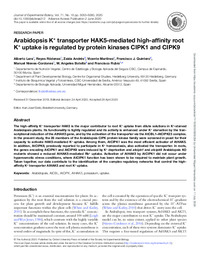Título :
Arabidopsis K+ transporter HAK5-mediated high-affinity root K+ uptake is regulated by protein kinases CIPK1 and CIPK9 |
Autor :
Lara, Alberto
Ródenas, Reyes
Andrés, Zaida
Martínez, Vicente
Quintero, Francisco J. 
Nieves-Cordones, Manuel 
Botella, M. Ángeles 
Rubio, Francisco |
Editor :
Oxford University Press |
Departamento:
Departamentos de la UMH::Biología Aplicada |
Fecha de publicación:
2020-06 |
URI :
https://hdl.handle.net/11000/32436 |
Resumen :
The high-affinity K+ transporter HAK5 is the major contributor to root K+ uptake from dilute solutions in K+-starved
Arabidopsis plants. Its functionality is tightly regulated and its activity is enhanced under K+ starvation by the transcriptional
induction of the AtHAK5 gene, and by the activation of the transporter via the AtCBL1–AtCIPK23 complex.
In the present study, the 26 members of the Arabidopsis CIPK protein kinase family were screened in yeast for their
capacity to activate HAK5-mediated K+ uptake. Among them, AtCIPK1 was the most efficient activator of AtHAK5.
In addition, AtCIPK9, previously reported to participate in K+ homeostasis, also activated the transporter. In roots,
the genes encoding AtCIPK1 and AtCIPK9 were induced by K+ deprivation and atcipk1 and atcipk9 Arabidopsis KO
mutants showed a reduced AtHAK5-mediated Rb+ uptake. Activation of AtHAK5 by AtCIPK1 did not occur under
hyperosmotic stress conditions, where AtCIPK1 function has been shown to be required to maintain plant growth.
Taken together, our data contribute to the identification of the complex regulatory networks that control the highaffinity
K+ transporter AtHAK5 and root K+ uptake.
|
Palabras clave/Materias:
Arabidopsis
AtCBL
AtCIPK
AtHAK5
potassium
uptake |
Área de conocimiento :
CDU: Ciencias puras y naturales: Biología |
Tipo de documento :
info:eu-repo/semantics/article |
Derechos de acceso:
info:eu-repo/semantics/openAccess
Attribution-NonCommercial-NoDerivatives 4.0 Internacional |
DOI :
https://doi.org/10.1093/jxb/eraa212 |
Publicado en:
Journal of Experimental Botany, Vol. 71, No. 16 pp. 5053–5060, 2020 |
Aparece en las colecciones:
Artículos Biología Aplicada
|
 La licencia se describe como: Atribución-NonComercial-NoDerivada 4.0 Internacional.
La licencia se describe como: Atribución-NonComercial-NoDerivada 4.0 Internacional.
.png)
